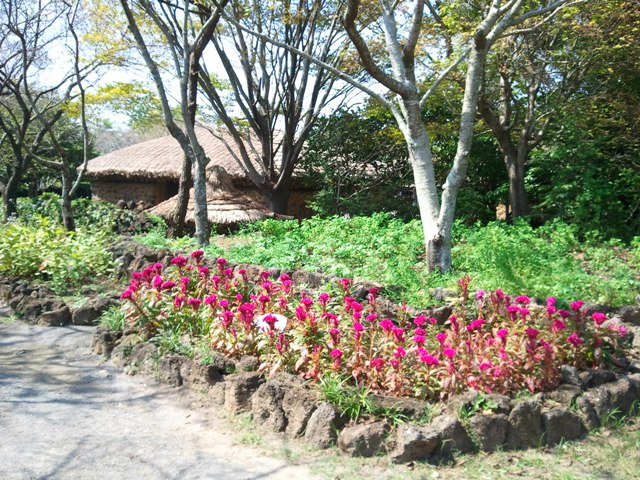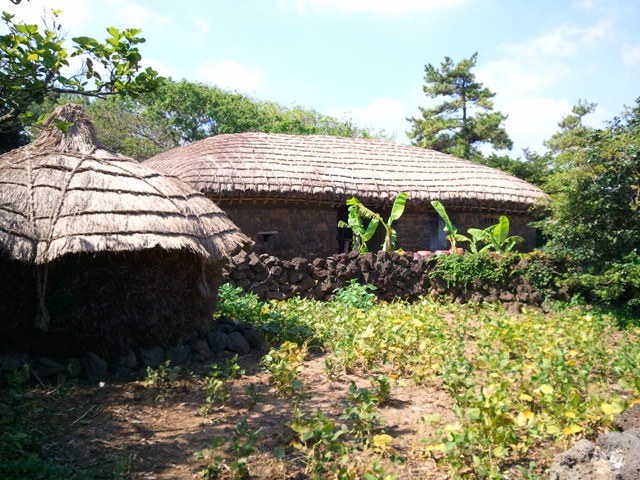|
| |
 |
|
| Nolgup Halmang's residing place, Jeju Folk Village, Pyoseon. Photo by Anne Hilty. |
The granaries of Jeju households were traditionally guarded by snakes.
Even today, not because it is the Year of the Snake but because in the villages these traditions are often still maintained, a ritual to the household snake deities is held around the time that the new lunar year begins.
During this ritual, the old “snake houses” (in their own way, a small temple to the snake goddess) are replaced and the year begins anew – just as the snake sheds its skin, thereby a symbol of longevity, renewal, and reincarnation.
The granaries are key to the prosperity of family and village, and fortune therefore attributed in large part to the granary deities.
Traditionally, every Jeju household had many gods (“ilban-sin,” known as “ga-sin” on the mainland). While snake worship is most strongly associated with villages in the eastern region of the island, all houses included the snake goddesses of the granaries – one inside, another outside – in the household pantheon.
Indeed, the snake spirit, as a household granary deity, was also worshiped throughout mainland Korea, where it is called “eopsin.”
The indoor granary (“gopang”), a separate room with a cupboard for the storage of grain and where the money and other valuables were also kept, was guarded by Gopang Halmang, also known as An (“inside”) Chilseong.
In the gopang, the various items were separated into clay pots with lids to keep out rodents and mold. In one or two pots, a rat snake was kept, to honor Gopang Halmang. During memorial services (“myeong-jeol”), a wooden board was placed over these clay pots and an altar thus erected to Gopang Halmang; only women could set up and worship at this altar.
The outdoor granary, guarded by Nulgup Halmang or Bat (“outside”) Chilseong, was a cone-shaped structure made of either barley or rice stored on the stalk, which served as food for livestock. This was raised above the ground on a wooden platform (“nulgup”), also to protect it from mold and rodents. Root vegetables were stored beneath this platform, and it was believed that Nulgup Halmang was in residence there.
| |
 |
|
| Nolgup Halmang's residing place, Jeju Folk VIllage, Pyoseon. Photo by Anne Hilty. |
Chilseong, according to Jeju's Chilseong bonpuri (shamanist myth), is a snake goddess who came to Jeju from China; a pregnant girl placed in an iron box and cast into the sea by her parents, she became a snake and gave birth to six serpent offspring before landing on the shores of this island. Each snake became a goddess in Jeju. An Chilseong is the mother snake, and Bat Chilseong is her youngest daughter.
The mainland version of the Chilseong myth identifies these as seven sons, stars that make up the Big Dipper, or Ursa Major. This alternate myth was brought to Jeju by mainlanders during the Joseon era.
Snake worship on Jeju has always been maintained by the women. Women possess a direct relationship with the snake goddesses, a connection which is passed down in matrilineal fashion – from mother to daughter.
As a result, and also because women held the responsibility for household management including all resources, the gopang was a women-only room; men were forbidden. It was in this granary, this sacred room, that troubled women would often sequester and console themselves, where they could share their concerns with a goddess with whom they had a special affiliation.
In this way, the granary became women's cultural space, for both worship and healing.
Gopang Halmang, goddess of prosperity, rules not only the grains but the success of the harvest. She also provides the mistress of the household with spiritual and emotional comfort. As such, it is she who largely determines a family's fortune – and its fate.
–
Kim Soonie, Jeju native, is a mythologist and Jeju representative of the nation's Cultural Heritage Administration. Anne Hilty is a cultural health psychologist from New York who now makes Jeju Island her home. Interpretation / translation was provided by Han Youngsook, Jeju native and instructor at Jeju National University.
|





















